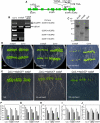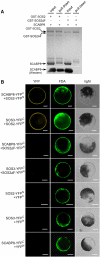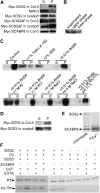SCABP8/CBL10, a putative calcium sensor, interacts with the protein kinase SOS2 to protect Arabidopsis shoots from salt stress
- PMID: 17449811
- PMCID: PMC1913747
- DOI: 10.1105/tpc.106.042291
SCABP8/CBL10, a putative calcium sensor, interacts with the protein kinase SOS2 to protect Arabidopsis shoots from salt stress
Abstract
The SOS (for Salt Overly Sensitive) pathway plays essential roles in conferring salt tolerance in Arabidopsis thaliana. Under salt stress, the calcium sensor SOS3 activates the kinase SOS2 that positively regulates SOS1, a plasma membrane sodium/proton antiporter. We show that SOS3 acts primarily in roots under salt stress. By contrast, the SOS3 homolog SOS3-LIKE CALCIUM BINDING PROTEIN8 (SCABP8)/CALCINEURIN B-LIKE10 functions mainly in the shoot response to salt toxicity. While root growth is reduced in sos3 mutants in the presence of NaCl, the salt sensitivity of scabp8 is more prominent in shoot tissues. SCABP8 is further shown to bind calcium, interact with SOS2 both in vitro and in vivo, recruit SOS2 to the plasma membrane, enhance SOS2 activity in a calcium-dependent manner, and activate SOS1 in yeast. In addition, sos3 scabp8 and sos2 scabp8 display a phenotype similar to sos2, which is more sensitive to salt than either sos3 or scabp8 alone. Overexpression of SCABP8 in sos3 partially rescues the sos3 salt-sensitive phenotype. However, overexpression of SOS3 fails to complement scabp8. These results suggest that SCABP8 and SOS3 are only partially redundant in their function, and each plays additional and unique roles in the plant salt stress response.
Figures









Similar articles
-
Phosphorylation of SOS3-LIKE CALCIUM BINDING PROTEIN8 by SOS2 protein kinase stabilizes their protein complex and regulates salt tolerance in Arabidopsis.Plant Cell. 2009 May;21(5):1607-19. doi: 10.1105/tpc.109.066217. Epub 2009 May 15. Plant Cell. 2009. PMID: 19448033 Free PMC article.
-
PLATZ2 negatively regulates salt tolerance in Arabidopsis seedlings by directly suppressing the expression of the CBL4/SOS3 and CBL10/SCaBP8 genes.J Exp Bot. 2020 Sep 19;71(18):5589-5602. doi: 10.1093/jxb/eraa259. J Exp Bot. 2020. PMID: 32453821
-
Arabidopsis AINTEGUMENTA mediates salt tolerance by trans-repressing SCABP8.J Cell Sci. 2015 Aug 1;128(15):2919-27. doi: 10.1242/jcs.172072. Epub 2015 Jun 8. J Cell Sci. 2015. PMID: 26054800
-
A Salt Overly Sensitive Pathway Member from Brassica juncea BjSOS3 Can Functionally Complement ΔAtsos3 in Arabidopsis.Curr Genomics. 2018 Jan;19(1):60-69. doi: 10.2174/1389202918666170228133621. Curr Genomics. 2018. PMID: 29491733 Free PMC article. Review.
-
Salt and drought stress signal transduction in plants.Annu Rev Plant Biol. 2002;53:247-73. doi: 10.1146/annurev.arplant.53.091401.143329. Annu Rev Plant Biol. 2002. PMID: 12221975 Free PMC article. Review.
Cited by
-
Emergence of a novel calcium signaling pathway in plants: CBL-CIPK signaling network.Physiol Mol Biol Plants. 2008 Apr;14(1-2):51-68. doi: 10.1007/s12298-008-0005-3. Epub 2008 Jun 15. Physiol Mol Biol Plants. 2008. PMID: 23572873 Free PMC article.
-
Genome-wide screening of salt tolerant genes by activation-tagging using dedifferentiated calli of Arabidopsis and its application to finding gene for Myo-inositol-1-p-synthase.PLoS One. 2015 May 15;10(5):e0115502. doi: 10.1371/journal.pone.0115502. eCollection 2015. PLoS One. 2015. PMID: 25978457 Free PMC article.
-
The tomato calcium sensor Cbl10 and its interacting protein kinase Cipk6 define a signaling pathway in plant immunity.Plant Cell. 2013 Jul;25(7):2748-64. doi: 10.1105/tpc.113.113530. Epub 2013 Jul 31. Plant Cell. 2013. PMID: 23903322 Free PMC article.
-
S-acylated and nucleus-localized SALT OVERLY SENSITIVE3/CALCINEURIN B-LIKE4 stabilizes GIGANTEA to regulate Arabidopsis flowering time under salt stress.Plant Cell. 2023 Jan 2;35(1):298-317. doi: 10.1093/plcell/koac289. Plant Cell. 2023. PMID: 36135824 Free PMC article.
-
Involvement of SlSOS2 in tomato salt tolerance.Bioengineered. 2012 Sep-Oct;3(5):298-302. doi: 10.4161/bioe.20796. Epub 2012 Jul 24. Bioengineered. 2012. PMID: 22825351 Free PMC article.
References
-
- Albrecht, V., Weinl, S., Blazevic, D., D'Angelo, C., Batistic, O., Kolukisaoglu, U., Bock, R., Harter, K., and Kudla, J. (2003). The calcium sensor CBL1 integrates plant responses to abiotic stresses. Plant J. 36 457–470. - PubMed
-
- Alonso, J.M., et al. (2003). Genome-wide insertional mutagenesis of Arabidopsis thaliana. Science 301 653–657. - PubMed
-
- Batistic, O., and Kudla, J. (2004). Integration and channeling of calcium signaling through the CBL calcium sensor/CIPK protein kinase network. Planta 219 915–924. - PubMed
-
- Cheng, N.-H., Pittman, J.K., Zhu, J.-K., and Hirschi, K.D. (2004). The protein kinase SOS2 activates the Arabidopsis H+/Ca2+ antiporter CAX1 to integrate calcium transport and salt tolerance. J. Biol. Chem. 279 2922–2926. - PubMed
Publication types
MeSH terms
Substances
LinkOut - more resources
Full Text Sources
Molecular Biology Databases
Miscellaneous

